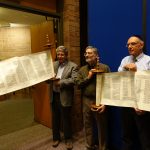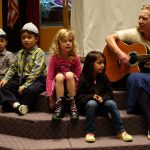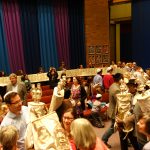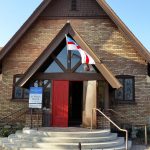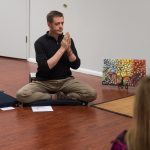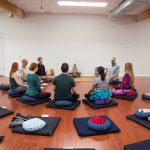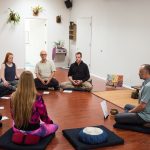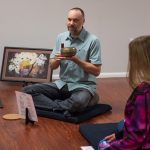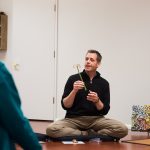BYU religion professor Keith Wilson said he’s not a worrier, but thinking about losing 10-20 percent of his students to inactivity — the number he estimates will go inactive while at BYU or afterward — makes him ache inside.
A 2016 study by the Pew Research Center found levels of religious commitment are declining in the U.S., especially among the millennial generation.
The study examined data from a previous 2014 study to determine what causes more Americans to identify as “nones,” or religiously unaffiliated.
The number of millennials identifying with “high religious commitment” fell from 50 percent in 2007 to 43 percent in 2014, according to the study. Similarly, the number of millennials with “low” religious commitment rose from 19 percent in 2007 to 29 percent in 2014.
Different religious groups around Utah Valley are responding to this decline in religious retention in different ways.
Congregation Kol Ami, Jewish Community

Cantor Wendy Bat-Sarah said building a sense of community in addition to emphasizing intellectual growth are the most important ways she seeks to keep her congregation and youth actively involved.
“You want as many touch points as possible,” Bat-Sarah said. “You want to have a barbecue for young families. You want to have a parent-ed group. You want to have a coffee on a Sunday morning.”
Bat-Sarah said the recent surge of Jewish converts has changed the way Judaism is practiced because it includes people of all backgrounds.
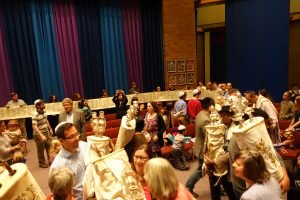
“Judaism itself changes with every generation,” Bat-Sarah said. “This is a totally unique time in Jewish history, and we’re rising to that challenge and making sure we include all the different ways of being Jewish.”
Bat-Sarah is in charge of teaching the congregation’s after-school religious program for youth. She said this program is another way she tries to bring the young Jewish community together by teaching them Hebrew, Jewish traditions and Jewish history.
“My job becomes providing this wonderful curriculum for their kids and also providing ways for all of the families to be enriched and to know each other and to want to keep coming around,” Bat-Sarah said. “That’s my goal.”
Peter Van Hook, priest-in-charge at St. Mary’s Episcopal Church, said worship and creating relationships — not membership — are the most important aspects they emphasize in the Episcopal Church.

“What attracts people and keeps people connected is not program, but worship,” Van Hook said. “What we work hard at is making sure that our worship is rooted in our tradition of ‘lex orandi lex credendi’ — worship that is divine and devout and engages people.”
Van Hook said the Latin phrase “Lex orandi lex credendi” is best understood in English as “worship shapes belief,” and is why the Episcopal tradition focuses more on connecting the worshipper with God and other worshippers than on sermons or preaching.
“It’s all about relationships, but it’s the relationships that are formed and supported by our common worship together. Other things grow out of that,” Van Hook said.
Awakening Valley Sangha, Buddhist Community
Co-founders Lon Young and John Judd said while they support the members of the Awakening Valley Sangha on their own spiritual journeys, they have no interest in retaining members.
“Buddhism recognizes the role mentors and guides can play in our life, but understands that they are merely fingers pointing to the moon,” Young said in an email. “If someone finds the moon by following someone else’s finger, then we rejoice for them.”
While faith is essential for spiritual practice in Buddhism, Young and Judd said they see themselves as facilitators rather than religious leaders and don’t want to force faith on anyone.
“We are grateful when others choose to come and explore these teachings and mindfulness practices with us, but no one should feel obligated to come back the next week,” Judd said in an email.
St. Francis of Assisi Catholic Church
Reverend David Bittmenn of Saint Francis of Assisi Catholic Church said while retention is an important part of his role at St. Francis, he wants to respect a person’s free will.
Bittmenn said there are many ways he and other members of the Catholic community reach out to others while still respecting individual choices.
“We continue to preach. We continue with visiting the sick,” Bittmenn said. “We continue with small community outreach. We continue with youth organizations and youth groups, and we continue with religious (education) classes.”
The Church of Jesus Christ of Latter-day Saints
Brad Wilcox, an associate BYU professor of ancient scripture, said the creation of young single adult wards and stakes by the Church has improved keeping track of and taking care of millennials who may fall through the cracks.
BYU religion professor Keith Wilson said lowering the age of missionary service, new “Face-to-Face” live broadcasts with Church leaders and the creation of youth programs have all been responses to the decline in millennial retention in the Church as well.
Wilcox said while retention is very important to the LDS Church, the number of people paying tithing or attending church are not the main reasons behind these efforts to keep LDS youth active.
“The thought that scares everyone is that then there are young people who are trying to face the world without the protection, the security (and) the help that religion can offer,” Wilcox said.

